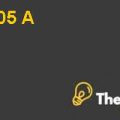a). Creating Dummy Variable
First, we have generated the dummy variable using the following codes:
DATA BINARYVARIABLE1;
SET TEST;
Group 1= (INTAKEGRP=<2520); Group 2= (INTAKEGRP>2520);
b). One-Way ANOVA
The code used for this model is as follows:
proc glm data=WTGAIN;
class 1 2 3 4;
model Y=1 2;
run;
The F test value is 17.96 and the p value is less than 0.05 which is the level of significance, therefore, the mean weights along the four treatment groups differ significantly.
c). Two-Way ANOVA
The two way ANOVA has been performed without interaction since interaction of TRTGRP and INTAKEGRP is insignificant. The F test value is 13.63 and the p value is less than 0.05 which is the level of significance, therefore, the mean weights are significantly explained by the difference in the treatment group and the feeding intake for each subject.
d). ANCOVA
The code used to run this model is as follows:
proc glm data=WTGain;
class BLWEIGHT;
model PostTreatment = INTAKE PreTreatment / solution;
lsmeans WTGAIN / stderr pdiff cov out=adjmeans;
run;
proc print data=adjmeans;
run;
Sas Assignment Harvard Case Solution & Analysis
The F test value is 6.36 and the p value is 0.005 which is lower than the level of significance, therefore, the mean weight gain is significantly explained by the difference in the baseline weight and the feeding intake for each subject.
e). Contrast Statement
Treatment # 1 significantly impacts on the mean weight of the subjects unlike the other three treatments.
f). Summary
Overall, the analysis performed in SAS through different models shows that the weight gain as a result of the feeding intake among the four groups differs significantly from one another. The least impact on the weight gain has been seen for the first treatment group. Finally, the feeding intake of the subjects tends to have a significant impact on the weight gain of all the subjects during the trial but it differs in significance for each of the our treatment groups.
SAS OUTPUTS
Model 1
The ANOVA Procedure
Model: \ MODEL1
Dependent Variable: WTGAIN
Analysis of Variance
Sum of Mean
Source DF Squares Square F Value Pr > F
Model 4 9543.72074 2385.93019 46.69 <.0001 3 11535.3 1441.9 17.96340291 1.0674E-06 Error 195 9963.77926 51.09630 28 11974.6 1496.8 Corrected Total 199 19507 31 11104.7 Root MSE 38840.5411458333 R-Square 0.4119 Dependent Mean 9.76000 Adj R-Sq 0.2648 Coeff Var 3.33246 Parameter Estimates Parameter Standard Variable Label DF Estimate Error t Value Pr > |t|
Intercept Intercept 3 0.078552871 0.1882216 0.0213 1.697854884
WTGAIN Weight Gain 3 0.584361106 0.34915772 0.0183 1.169517177
Model 2
The ANOVA Procedure
Model: \ MODEL2
Dependent Variable: = WEIGHTGAIN
Analysis of Variance
Sum of Mean
Source DF Squares Square F Value Pr > F
Model 4 9543.72074 2385.93019 46.69 <.0001 5956 85793.98749 42897 13.63012728 6.71191E-05 Error 195 9963.77926 51.09630 4 91269.34719 3147.2 Corrected Total 199 19507 5960 177063.3347 Root MSE 11.53547 R-Square 0.4119 Dependent Mean 9.76000 Adj R-Sq 0.2648 Coeff Var 3.33246 Parameter Estimates Parameter Standard Variable Label DF Estimate Error t Value Pr > |t|
Intercept 2025.9 2 2025.896399 260.1126886 7.7885 1.37206E-08......
This is just a sample partical work. Please place the order on the website to get your own originally done case solution.










